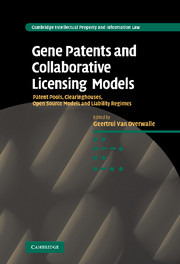 Gene Patents and Collaborative Licensing Models
Gene Patents and Collaborative Licensing Models Book contents
- Frontmatter
- Contents
- List of contributors
- Preface
- Foreword: Jean-Jacques Cassiman
- List of abbreviations
- Part I Patent pools
- 1 Patent pooling for gene-based diagnostic testing. Conceptual framework
- 2 Case 1. The MPEG LA® Licensing Model. What problem does it solve in biopharma and genetics?
- 3 Case 2. The SARS case. IP fragmentation and patent pools
- 4 Critical analysis of patent pools
- Part II Clearinghouses
- Part III Open source models
- Part IV Liability regimes
- Part V Different perspectives
- Part VI Summary and concluding analysis
- Index
- Titles in the series
1 - Patent pooling for gene-based diagnostic testing. Conceptual framework
from Part I - Patent pools
Published online by Cambridge University Press: 14 January 2010
- Frontmatter
- Contents
- List of contributors
- Preface
- Foreword: Jean-Jacques Cassiman
- List of abbreviations
- Part I Patent pools
- 1 Patent pooling for gene-based diagnostic testing. Conceptual framework
- 2 Case 1. The MPEG LA® Licensing Model. What problem does it solve in biopharma and genetics?
- 3 Case 2. The SARS case. IP fragmentation and patent pools
- 4 Critical analysis of patent pools
- Part II Clearinghouses
- Part III Open source models
- Part IV Liability regimes
- Part V Different perspectives
- Part VI Summary and concluding analysis
- Index
- Titles in the series
Summary
Introduction
The presence of a patent thicket in a certain technology inevitably leads to a high number of licenses required to gain access to the patented technology. Consequently, this may result in the accumulation of royalties to be paid (royalty stacking). Such a situation may cause hindrance of access to and subsequent under-use of the technology, which is described in literature as the anticommons effect. When access and use to a certain technology are hindered by the existence of multiple patents, held by multiple patent owners (a patent thicket), a patent pool might be a useful model to facilitate access.
Patent thickets have arisen in technical fields other than the genetic area and patent pools have emerged to deal with overlapping patents for a long time. One of the first patent pools was formed in 1856, by sewing machine manufacturers Grover, Baker, Singer, Wheeler and Wilson, all accusing the others of patent infringement. They met in Albany, New York to pursue their suits. Orlando B. Potter, a lawyer and president of the Grover and Baker Company, proposed that, rather than sue their profits out of existence, they pool their patents. In 1917, an aircraft pool was privately formed encompassing almost all aircraft manufacturers, which was crucial to the US government entering World War I. In the late 1990s several patent pools were formed in the ICT branch starting with the MPEG-2 pool in 1997 for inventions relating to the MPEG-2 standard with others to follow.
- Type
- Chapter
- Information
- Gene Patents and Collaborative Licensing ModelsPatent Pools, Clearinghouses, Open Source Models and Liability Regimes, pp. 3 - 32Publisher: Cambridge University PressPrint publication year: 2009
- 12
- Cited by
